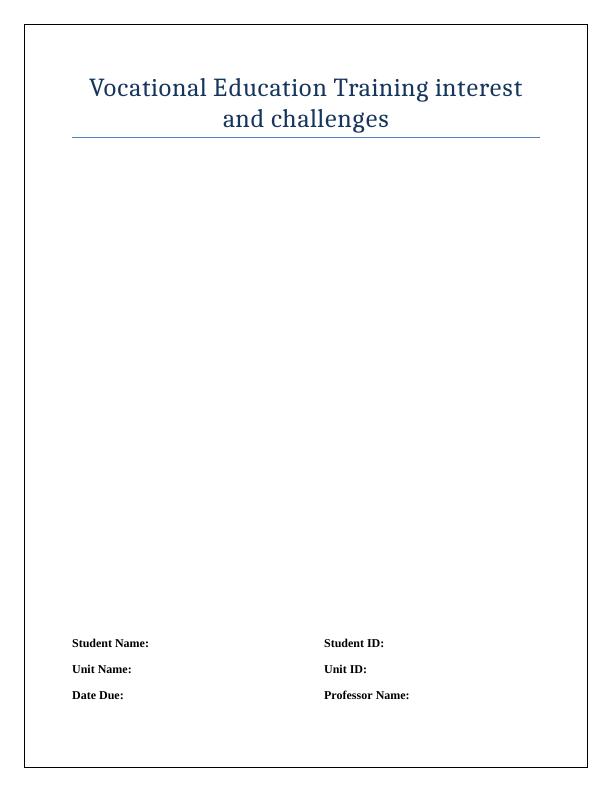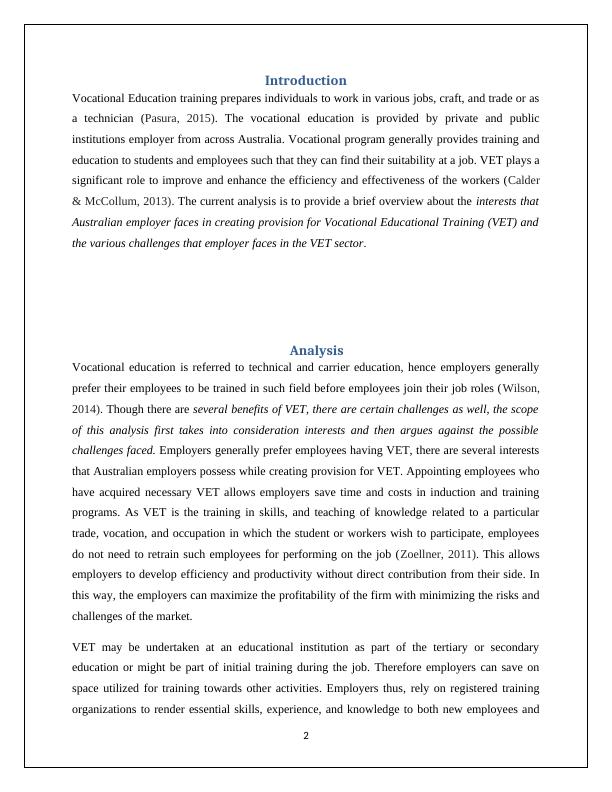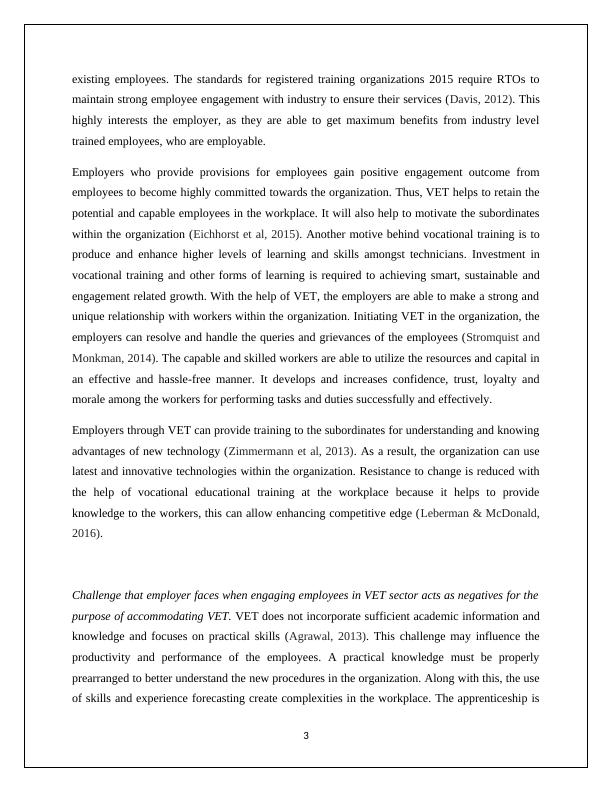Vocational Education Training interest and challenges Assignment
7 Pages1713 Words89 Views
Added on 2021-05-31
Vocational Education Training interest and challenges Assignment
Added on 2021-05-31
ShareRelated Documents
Vocational Education Training interestand challengesStudent Name:Student ID:Unit Name:Unit ID:Date Due:Professor Name:

IntroductionVocational Education training prepares individuals to work in various jobs, craft, and trade or asa technician (Pasura, 2015). The vocational education is provided by private and publicinstitutions employer from across Australia. Vocational program generally provides training andeducation to students and employees such that they can find their suitability at a job. VET plays asignificant role to improve and enhance the efficiency and effectiveness of the workers (Calder& McCollum, 2013). The current analysis is to provide a brief overview about the interests thatAustralian employer faces in creating provision for Vocational Educational Training (VET) andthe various challenges that employer faces in the VET sector. AnalysisVocational education is referred to technical and carrier education, hence employers generallyprefer their employees to be trained in such field before employees join their job roles (Wilson,2014). Though there are several benefits of VET, there are certain challenges as well, the scopeof this analysis first takes into consideration interests and then argues against the possiblechallenges faced. Employers generally prefer employees having VET, there are several intereststhat Australian employers possess while creating provision for VET. Appointing employees whohave acquired necessary VET allows employers save time and costs in induction and trainingprograms. As VET is the training in skills, and teaching of knowledge related to a particulartrade, vocation, and occupation in which the student or workers wish to participate, employeesdo not need to retrain such employees for performing on the job (Zoellner, 2011). This allowsemployers to develop efficiency and productivity without direct contribution from their side. Inthis way, the employers can maximize the profitability of the firm with minimizing the risks andchallenges of the market.VET may be undertaken at an educational institution as part of the tertiary or secondaryeducation or might be part of initial training during the job. Therefore employers can save onspace utilized for training towards other activities. Employers thus, rely on registered trainingorganizations to render essential skills, experience, and knowledge to both new employees and2

existing employees. The standards for registered training organizations 2015 require RTOs tomaintain strong employee engagement with industry to ensure their services (Davis, 2012). Thishighly interests the employer, as they are able to get maximum benefits from industry leveltrained employees, who are employable. Employers who provide provisions for employees gain positive engagement outcome fromemployees to become highly committed towards the organization. Thus, VET helps to retain thepotential and capable employees in the workplace. It will also help to motivate the subordinateswithin the organization (Eichhorst et al, 2015). Another motive behind vocational training is toproduce and enhance higher levels of learning and skills amongst technicians. Investment invocational training and other forms of learning is required to achieving smart, sustainable andengagement related growth. With the help of VET, the employers are able to make a strong andunique relationship with workers within the organization. Initiating VET in the organization, theemployers can resolve and handle the queries and grievances of the employees (Stromquist andMonkman, 2014). The capable and skilled workers are able to utilize the resources and capital inan effective and hassle-free manner. It develops and increases confidence, trust, loyalty andmorale among the workers for performing tasks and duties successfully and effectively. Employers through VET can provide training to the subordinates for understanding and knowingadvantages of new technology (Zimmermann et al, 2013). As a result, the organization can uselatest and innovative technologies within the organization. Resistance to change is reduced withthe help of vocational educational training at the workplace because it helps to provideknowledge to the workers, this can allow enhancing competitive edge (Leberman & McDonald,2016).Challenge that employer faces when engaging employees in VET sector acts as negatives for thepurpose of accommodating VET. VET does not incorporate sufficient academic information andknowledge and focuses on practical skills (Agrawal, 2013). This challenge may influence theproductivity and performance of the employees. A practical knowledge must be properlyprearranged to better understand the new procedures in the organization. Along with this, the useof skills and experience forecasting create complexities in the workplace. The apprenticeship is3

End of preview
Want to access all the pages? Upload your documents or become a member.
Related Documents
Vocational Education Training (VET)lg...
|7
|1827
|66
Human Resource Development: Essaylg...
|8
|1769
|91
Interests And Challenges That Australian Employers Have In The Provision Of VET8 Report 2022lg...
|8
|1792
|19
Vocational Education Training interest and challenges Assignmentlg...
|8
|1971
|231
Vocational Education and Training in Australia: Interests and Challengeslg...
|7
|1850
|377
Interest of Australian Employers in Vocational Education Traininglg...
|7
|1777
|450
